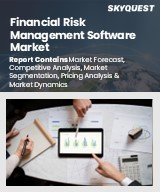
세계의 금융 위험 관리 소프트웨어 시장 규모는 2023년 45억 달러로 평가되었고, 2024년 48억 3,000만 달러에서 2032년에는 85억 6,000만 달러에 이를 것으로 예측되며, 예측기간(2025-2032년)의 CAGR은 7.4%를 나타낼 전망입니다.
세계의 금융 위험 관리 소프트웨어 시장은 금융 운영의 복잡성 증가, 진화하는 규제 요구사항, 실시간 위험 평가의 필요성에 힘입어 상당한 확장을 경험하고 있습니다. 다양한 분야의 조직들은 시장 변동성, 유동성 문제, 신용 노출로 인한 위협을 완화하기 위해 점점 더 진보된 위험 관리 솔루션을 채택하고 있습니다. 디지털 뱅킹의 등장, 핀테크 혁신, AI 및 빅데이터 분석의 통합은 위험 매개변수를 신속하게 평가하고 의사결정 프로세스를 개선할 수 있는 소프트웨어 수요를 높이고 있습니다. 또한 사이버 보안 위협의 증가와 클라우드 기반 기술의 출현은 기업들이 잠재적 실패로부터 운영을 보호하기 위해 확장 가능한 위험 관리 솔루션에 투자하도록 촉구하고 있습니다. 그러나 높은 구현 비용과 숙련된 전문가 풀의 한계는 특히 중소기업에게 도전 과제로 작용합니다.
Global Financial Risk Management Software Market size was valued at USD 4.5 billion in 2023 and is poised to grow from USD 4.83 billion in 2024 to USD 8.56 billion by 2032, growing at a CAGR of 7.4% during the forecast period (2025-2032).
The Global Financial Risk Management Software market is witnessing significant expansion driven by the rising intricacies of financial operations, evolving regulatory demands, and the necessity for real-time risk evaluations. Organizations across various sectors are increasingly adopting advanced risk management solutions to mitigate threats emanating from market volatility, liquidity challenges, and credit exposure. The emergence of digital banking, fintech innovations, and the integration of AI and big data analytics are elevating the demand for software that can swiftly assess risk parameters and enhance decision-making processes. Furthermore, escalating cybersecurity threats and the advent of cloud-based technologies prompt businesses to invest in scalable risk management solutions to safeguard their operations from potential failures. However, high implementation costs and a limited pool of skilled professionals present challenges, particularly for smaller enterprises.
Top-down and bottom-up approaches were used to estimate and validate the size of the Global Financial Risk Management Software market and to estimate the size of various other dependent submarkets. The research methodology used to estimate the market size includes the following details: The key players in the market were identified through secondary research, and their market shares in the respective regions were determined through primary and secondary research. This entire procedure includes the study of the annual and financial reports of the top market players and extensive interviews for key insights from industry leaders such as CEOs, VPs, directors, and marketing executives. All percentage shares split, and breakdowns were determined using secondary sources and verified through Primary sources. All possible parameters that affect the markets covered in this research study have been accounted for, viewed in extensive detail, verified through primary research, and analyzed to get the final quantitative and qualitative data.
Global Financial Risk Management Software Market Segments Analysis
Global Financial Risk Management Software Market is segmented by Deployment Model, Function, Industry Vertical and region. Based on Deployment Model, the market is segmented into On-premises and Cloud. Based on Function, the market is segmented into Credit Risk Management, Market Risk Management, Operational Risk Management, Liquidity Risk Management, FX Risk Management, Enterprise Risk Management, Basel Accords Compliance and Solvency II Compliance. Based on Industry Vertical, the market is segmented into Banking and Financial Services, Insurance, Healthcare, Manufacturing, Energy and Utilities, Retail and Consumer Goods and Government and Non-profit. Based on region, the market is segmented into North America, Europe, Asia Pacific, Latin America and Middle East & Africa.
Driver of the Global Financial Risk Management Software Market
The Global Financial Risk Management Software market is driven by the necessity for financial institutions to adapt to an evolving regulatory landscape, characterized by diverse frameworks like Basel III, Solvency II, MiFID II, and GDPR. To satisfy stakeholder demands for compliance and transparency, these institutions increasingly rely on advanced financial risk management software, which streamlines reporting, creates comprehensive audit trails of decision-making processes, and facilitates automatic risk assessments. This technology not only aids in minimizing regulatory penalties for businesses but also enhances overall governance and fosters a culture conducive to measured risk-taking within the organization.
Restraints in the Global Financial Risk Management Software Market
The Global Financial Risk Management Software market faces obstacles stemming from the high capital requirements necessary for comprehensive financial risk management systems. Organizations must invest substantially in hardware, software licensing, and extensive customizations, which can be particularly burdensome for small and medium-sized enterprises (SMEs). The financial commitment for both the initial setup and ongoing maintenance, including necessary training, can be prohibitively expensive. This is especially true in regions where information technology budgets are constrained or where the financial sector is still in developmental stages, leading to potential hesitance in adopting advanced risk management solutions.
Market Trends of the Global Financial Risk Management Software Market
The Global Financial Risk Management Software market is witnessing a significant shift towards AI-powered risk modeling, driven by financial institutions leveraging advanced audiovisual tools to enhance their risk assessment capabilities. This trend emphasizes the utilization of explainable AI integrated with natural language processing, enabling brokers to gain deeper insights into risk factors, fraud detection, and credit exposure modeling. Moreover, the enhanced auditability and transparency of these AI tools cater to the evolving regulatory landscape, particularly in sectors such as banking and insurance, ensuring compliance while optimizing risk management strategies. Consequently, this innovation is set to revolutionize how organizations approach financial risk management.